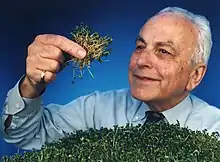Paul Talalay
Paul Talalay (* 31. März 1923 in Berlin; † 10. März 2019 in Baltimore)[1] war ein US-amerikanischer Pharmakologe. Er war Professor für Pharmakologie und leitete das Labor für Molekularwissenschaften der Johns Hopkins School of Medicine in Baltimore. Außerdem gründete er das Brassica Chemoprotection Laboratory zur Untersuchung essbarer Pflanzen, die eine schützende Enzymaktivität im Körper erzeugen können und dadurch helfen könnten, der Entstehung von Krebs vorzubeugen.

Leben
Paul Talalay war ein Sohn des Joseph Anton Talalay und der Sophie Brosterman. Die Familie verließ kurz nach der Machtübernahme durch die Nationalsozialisten Deutschland und ging nach England.[2] Talalay besuchte die Bedford School und ging 1940 in die Vereinigten Staaten, wo er am Massachusetts Institute of Technology Biologie studierte. Ab 1944 studierte er an der University of Chicago und ab 1946 an der Yale School of Medicine. Im Jahr 1948 promovierte er. Ab 1950 erforschte er an der University of Chicago Steroidhormone. Von 1962 bis 1974 leitete Talalay die Abteilung für Pharmakologie und experimentelle Arzneimittel der Johns Hopkins School of Medicine. Ab 1974 war er Professor für Pharmakologie.[3]
Talalay widmete sich der Erforschung von Krebs. Er entwickelte mit seinen Kollegen einfache Methoden zur Zellkultur für den Nachweis von Phytochemikalien, die Enzyme verstärken, die im Körper Karzinogene entgiften. Diese Arbeit führte zur Isolierung von Sulforaphan, das in Brokkoli enthalten ist und Phase-II-Enzyme aktiviert. Die Ergebnisse wurden 1992 veröffentlicht[4] und trugen zum Verständnis des Zusammenhangs zwischen dem Verzehr von Kreuzblütlern und einem verringerten Krebsrisiko bei.[5][6][7][8][9][10][11][12][13][14]
Talalay erhielt eine lebenslange Professur der American Cancer Society. Er war Mitglied der National Academy of Sciences, der American Philosophical Society und der American Academy of Arts and Sciences.[15] Die M.D. – Ph.D. Student Library der Johns Hopkins University wurde nach ihm benannt.[16]
Talalay heiratete 1953 Pamela Judith Samuels, sie hatten vier Kinder, darunter die Filmemacherin Rachel Talalay.
Literatur
- Talalay, Paul, in: Werner Röder; Herbert A. Strauss (Hrsg.): International Biographical Dictionary of Central European Emigrés 1933–1945. Band 2,2. München : Saur, 1983, S. 1152
Einzelnachweise
- Paul Talalay, researcher who found cancer-preventing qualities in broccoli, dies at 95. In: The Washington Post. 13. März 2019, abgerufen am 14. März 2019.
- Dr. Paul Talalay, Johns Hopkins molecular pharmacologist who made broccoli famous as a cancer fighter, dies. In: The Baltimore Sun. 13. März 2019, abgerufen am 14. März 2019.
- Paul Talalay: A Fascination with Enzymes: The Journey Not the Arrival Matters. In: Journal of Biological Chemistry. 280. Jahrgang, Nr. 32, 12. August 2005, S. 28829–28847, doi:10.1074/jbc.X500004200, PMID 15941714.
- Susan Talalay – There's more to life than broccoli Anti-cancer researcher would like to get past the B-word fixation – Baltimore Sun. In: Baltimore Sun. Abgerufen am 2. Oktober 2014.
- Nicole Kresge, Robert D. Simoni, Robert L. Hill: Steroid Metabolizing Enzymes and Cancer: the Work of Paul Talalay. In: Journal of Biological Chemistry. 282. Jahrgang, Nr. 33, 17. August 2007, S. e27–e28, doi:10.1016/S0021-9258(20)54434-7.
- Hopkins scientists expand their 20-year mission to understand the disease-deterring benefits of a potent plant compound found in broccoli. Johns Hopkins Medicine: „Talalay discovered a compound that demonstrated a powerful ability to protect cells from the sort of damage that can instigate cancer. The compound, sulforaphane, .. Since then, dozens of journal articles have flowed from the discovery“
- Emily Langer: Paul Talalay: Scientist who found in broccoli sprouts an aid to preventing cancer In: The Independent, 24. März 2019 „But Talalay was keen to avoid hype. 'Do I tell everybody to eat broccoli sprouts? No, and we can't say that eating sprouts will guarantee you won't get cancer or heart disease. But I believe they are protective.'“
- Kristi A. Steinmetz, John D. Potter, Aaron R. Folsom: Vegetables, Fruit, and Lung Cancer in the Iowa Women's Health Study. In: Cancer Research. 53. Jahrgang, Nr. 3, 1. Februar 1993, S. 536–543, PMID 8425185 (aacrjournals.org).
- Vladimir J. Lozanovski, Georgios Polychronidis, Wolfgang Gross, Negin Gharabaghi, Arianeb Mehrabi, Thilo Hackert, Peter Schemmer, Ingrid Herr: Broccoli sprout supplementation in patients with advanced pancreatic cancer is difficult despite positive effects—results from the POUDER pilot study. In: Investigational New Drugs. 38. Jahrgang, Nr. 3, Juni 2020, S. 776–784, doi:10.1007/s10637-019-00826-z, PMID 31250356, PMC 7211206 (freier Volltext).
- Yanyan Li, Tao Zhang, Hasan Korkaya, Suling Liu, Hsiu-Fang Lee, Bryan Newman, Yanke Yu, Shawn G. Clouthier, Steven J. Schwartz, Max S. Wicha, Duxin Sun: Sulforaphane, a Dietary Component of Broccoli/Broccoli Sprouts, Inhibits Breast Cancer Stem Cells. In: Clinical Cancer Research. 16. Jahrgang, Nr. 9, 1. Mai 2010, S. 2580–2590, doi:10.1158/1078-0432.CCR-09-2937, PMID 20388854, PMC 2862133 (freier Volltext).
- Y. Zhang, P. Talalay, C. G. Cho, G. H. Posner: A major inducer of anticarcinogenic protective enzymes from broccoli: isolation and elucidation of structure. In: Proceedings of the National Academy of Sciences. 89. Jahrgang, Nr. 6, 15. März 1992, S. 2399–2403, doi:10.1073/pnas.89.6.2399, PMID 1549603, PMC 48665 (freier Volltext), bibcode:1992PNAS...89.2399Z.
- John D. Clarke, Roderick H. Dashwood, Emily Ho: Multi-targeted prevention of cancer by sulforaphane. In: Cancer Letters. 269. Jahrgang, Nr. 2, 8. Oktober 2008, S. 291–304, doi:10.1016/j.canlet.2008.04.018, PMID 18504070, PMC 2579766 (freier Volltext).
- Jed W. Fahey, Yuesheng Zhang, Paul Talalay: Broccoli sprouts: An exceptionally rich source of inducers of enzymes that protect against chemical carcinogens. In: Proceedings of the National Academy of Sciences. 94. Jahrgang, Nr. 19, 16. September 1997, S. 10367–10372, doi:10.1073/pnas.94.19.10367, PMID 9294217, PMC 23369 (freier Volltext), bibcode:1997PNAS...9410367F.
- Yuesheng Zhang, Li Tang: Discovery and development of sulforaphane as a cancer chemopreventive phytochemical. In: Acta Pharmacologica Sinica. 28. Jahrgang, Nr. 9, September 2007, S. 1343–1354, doi:10.1111/j.1745-7254.2007.00679.x, PMID 17723168.
- Book of Members 1780–present, Chapter T. (PDF; 888 kB) In: amacad.org. American Academy of Arts and Sciences, abgerufen am 6. Juni 2022 (englisch).
- A Nibble of Prevention. In: Johns Hopkins Magazine.